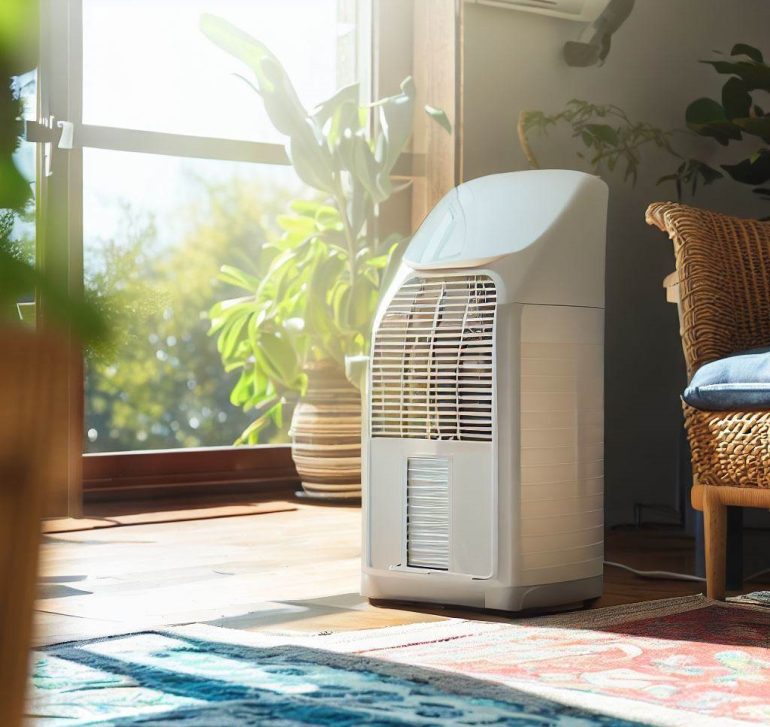It’s no secret that high humidity levels can make it difficult to regulate body temperature and feel comfortable. Nevertheless, a dehumidifier can be valuable in the summer months as it aids in annihilating excessive moisture from the air, enriching air quality, and creating a more comfortable indoor environment.
During the summer season, increased temperatures can cause humidity levels to rise. This increase in moisture can lead to a range of issues, including mould growth, dust mites, and respiratory problems.
Using a dehumidifier, you can effectively manage these issues while improving overall comfort levels in your home or workspace. So why suffer through hot and humid conditions when a simple solution is readily available?
Read on to discover the benefits of using a dehumidifier during the summer months.
Key Takeaways
- Dehumidifiers can help control how warm the air feels and keep you comfortable in the summer by reducing moisture in the air.
- High humidity can make areas feel stuffy, uncomfortable, and claustrophobic and also make it harder for the body to cool itself off efficiently.
- Using a dehumidifier in combination with air movers like fans can improve results and make the air temperature feel cooler.
- The benefits of using a dehumidifier in the summer include improving air quality, diminishing dust mites, and preventing mould growth. Nonetheless, it’s vital to know what humidity level you are looking to acquire and not withdraw too much moisture from the air, which can cause dry air and irritate the nose and throat.
Can a dehumidifier help to cool a room during the summer months?

Were you aware that a dehumidifier not only enhances air quality and reduces moisture but also aids in creating a cooler atmosphere by eliminating excess humidity, which can otherwise make the air feel warmer? In periods of high humidity, it can pose a challenge for your body to regulate its temperature effectively through perspiration. This is because sweat can’t evaporate efficiently from your skin when there’s too much moisture in the air.
By investing in a dehumidifier during the summer months, you can reduce this effect and make your environment more comfortable. Dehumidifiers work by removing water vapour from the air until it reaches an optimal humidity level. This process allows you to control how warm or cool the air feels without having to adjust your thermostat constantly.
However, it’s important to use dehumidifiers efficiently and combine them with other techniques like air movement. By using fans or other devices to circulate dry air throughout your home, you can enhance the effects of your dehumidifier and create a more comfortable living space.
To achieve optimal results with a dehumidifier, you should aim for an indoor humidity level between 30-50%. This range will help prevent mould growth, reduce dust mites, and improve your overall comfort levels during hot weather. With proper usage and air movement techniques, a dehumidifier can make all the difference in creating a cool and comfortable home environment this summer season!
What causes higher summer humidity levels?

Hot summer air can feel like a suffocating blanket, clinging to your skin with oppressive humidity. The discomfort arises from the high levels of water vapour in the air, which tend to increase during the summer months to higher temperatures.
Warmer air can hold more moisture than colder air, leading to higher relative humidity levels. High humidity levels not only make you feel uncomfortable but can also have negative effects on your health. When humidity is high, it becomes harder for the body to cool itself off efficiently through sweating.
Sweat cannot evaporate from the body as fast, trapping heat on the skin and making you feel hotter. Additionally, high humidity levels provide an ideal environment for mould growth and dust mites that can trigger allergies or asthma.
To reduce summer humidity levels in your home or office, it’s important to monitor indoor humidity using a hygrometer. The ideal range for indoor relative humidity is between 30% and 50%. Installing a dehumidifier can help remove excess moisture from the air and improve air quality while reducing dust mites and preventing mould growth.
Combining a dehumidifier with fans or other air movers can improve results even further. It’s essential to know what level of humidity you’re looking to achieve since removing too much moisture from the air may cause dryness that irritates your nose and throat.
Why does the presence of humidity make it feel hotter?
When humidity levels are high, your body has a harder time cooling down through sweating. Sweat can’t evaporate from your skin as fast due to the moisture in the air, trapping heat on your skin and making you feel hotter. This can potentially result in discomfort and even health problems, including dehydration, heat exhaustion, and heat stroke.
To balance the adverse effects of humidity on your health, it is vital to stay well-hydrated by consuming ample amounts of water throughout the day. Additionally, improving air circulation with fans or opening windows can help reduce humidity levels and make you feel more comfortable. A dehumidifier can also be an effective tool in reducing excess moisture in the air.
Reducing humidity levels not only benefits your physical comfort but also improves indoor air quality by preventing mould growth and reducing dust mites. By using a dehumidifier along with other ways of improving air circulation, you can create a healthier and more relaxed environment for yourself during the hot summer months.
Why Use a dehumidifier during the summer season?
To keep your home environment comfortable and prevent health issues during the hot summer months, consider using a dehumidifier to control how warm the air feels and reduce excess moisture in the air. Here are some benefits of using a dehumidifier during the summer season:
- Enrich air quality and diminishes the presence of dust mites.
- Extracts moisture from the air, reducing humidity and creating a perception of cooler air temperature.
- Prevents the growth of mould, particularly in excessively humid summer conditions.
- Cost-effective to operate and available in various options to accommodate rooms of any size.
It’s important to maintain your dehumidifier throughout its usage period to ensure optimal performance. Some maintenance tips include cleaning or replacing filters regularly, checking drain hoses for any blockages, and ensuring proper ventilation around the unit.
Frequently Asked Questions
Can using a dehumidifier during the summer season help prevent allergies and respiratory issues?
Using a dehumidifier during the summer season can help prevent allergies and respiratory issues by reducing humidity levels. Lower humidity reduces mould growth, dust mites, and air pollutants that aggravate respiratory health conditions.
Are there any potential side consequences of using a dehumidifier for an extended period?
Extended use of dehumidifiers may lead to dryness in the air, which can cause discomfort and irritation in the nose and throat. Proper maintenance is necessary to prevent mould growth. Energy consumption should also be considered.
How long does it typically take for a dehumidifier to reduce the humidity level in a room?
The effectiveness of dehumidifiers in reducing humidity levels depends on various factors like room size, moisture level, and the dehumidifier model. Higher-capacity models can achieve desired results faster than lower-capacity units.
Is it possible to utilise a dehumidifier alongside an air conditioner during the summer to enhance indoor air quality?
Yes, a dehumidifier can be used with an air conditioner to improve indoor air quality during the summer. Air conditioner compatibility allows for moisture control and reduces energy consumption by improving efficiency.
Conclusion
With high humidity levels making indoor spaces feel stuffy and uncomfortable, it’s important to regulate the moisture in the air to improve air quality and make your environment more comfortable.
Not only does a dehumidifier help reduce dust mites and prevent mould growth, but it can also help regulate body temperature and keep you feeling cool.

